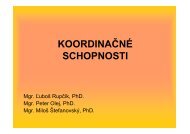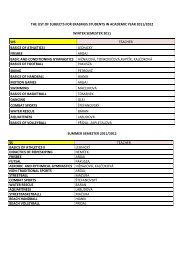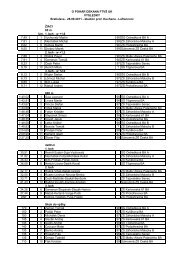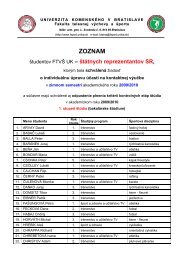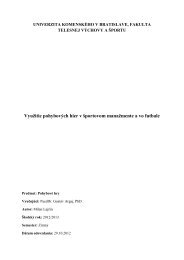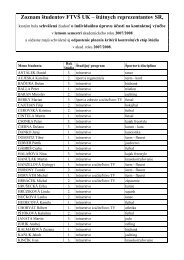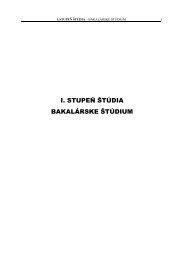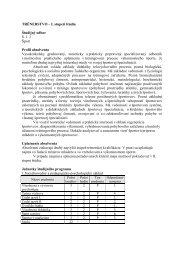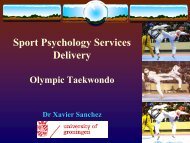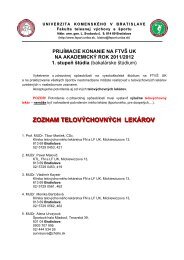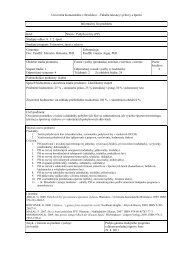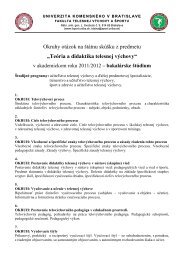acta facultatis educationis physicae universitatis comenianae
acta facultatis educationis physicae universitatis comenianae
acta facultatis educationis physicae universitatis comenianae
Create successful ePaper yourself
Turn your PDF publications into a flip-book with our unique Google optimized e-Paper software.
Analyze of sport talent selection systems<br />
19<br />
Talent<br />
Detection<br />
Talent<br />
Identification<br />
Talent<br />
Confirmation<br />
Talent<br />
Recognition/<br />
Orientation<br />
Talent<br />
Development/<br />
Special Training<br />
Talent Development Model<br />
Figure 1<br />
Principle model of Talent Recognition<br />
Comprehensive Talent Development model should address the issues of:<br />
• Talent development through one sports (straight forward one early sport career)<br />
• Talent migration/transfer) in case original talent identification wasn’t successful (dual to<br />
multiple early sport career)<br />
• Talent retention/recycling (transfer of talent in later stages of sport career)<br />
References<br />
1. FISHER, R. J., BORMS, J. 1990. The Search for Sporting Exellence. Scherndorf : Hoffman Verlag.<br />
146 p.<br />
2. GLESK, P., HARSANYI, L. 1998. Výber talentov so zameraním na atletiku. Bratislava : SAZ,<br />
1998. ISBN 80-227-1155-1.<br />
3. HARSÁNYI, L., MARTIN, M. 1983. Zur Auswahl sportlicher Talente. In Leistungsport, 13(2),<br />
1983, p. 21-24.<br />
4. HAVLÍČEK, I. 1982. Systém športovej prípravy talentovanej mládeže. In Tréner (6), 1982, p.<br />
242-245.<br />
5. HOARE, D. 1996.Coaching Focus, The National Coaching Foundation. Talent Identification and<br />
Development: The Australian Talent Search Programme, 1996.<br />
6. KRASILSHCHIKOV, O, SEBASTIAN, PJ, MANILAL, KP, SAJU JOSEPH, VC. 1995. The<br />
system of Long-term training and selection of talented sports persons. NIS Scientific Journal.<br />
Vol. 18, No 2. p. 26-40.<br />
7. KRASILSHCHIKOV, O. 2010. Talent Identification and Development – International Trends<br />
and Principle Models. Buletin Kejurulatihan Majlis Sukan Negara Malaysia, 2010, p. 5-15. ISSN<br />
2180-3773.<br />
8. MORAVEC et al 2004. Teória a didaktika športu. Bratislava : FTVŠ UK a SVS TVŠ, 2004. 212 p.<br />
ISBN 80-89075-22-3.<br />
9. PELTOLA, E. 1992. Talent Identification an Overview. IAAF: 7(3), 7-12.<br />
10. PLATONOV, VN. 2002. Teoria General del Entrenamiento Deportivo Olimpico. Paidotribo Editorial,<br />
2002. 686 p.<br />
11. SEDLÁČEK, J. et al 1994. The Inffluence of the Political Changes on the High Performance Sport<br />
Organization in Czechoslovakia. In WILCOX, CR Sport in the Global Village. Fitness Information<br />
Technology, Inc., 1994,p. 341-347. ISBN 0-9627926-4-0.<br />
12. WILLIAMS, AM, REILLY, T. 2000. Talent identification and development in soccer. Journal of<br />
Sports Sciences: 18, 657-667.<br />
13. WOODMAN, L. 1985. Talent identification – Is competition enough. Sports Coach: 9(1), 49-57.<br />
Acta Facultatis Educationis Physicae Universitatis Comenianae LII/I



